B2B Pricing Strategies: What Works, What Fails & Why
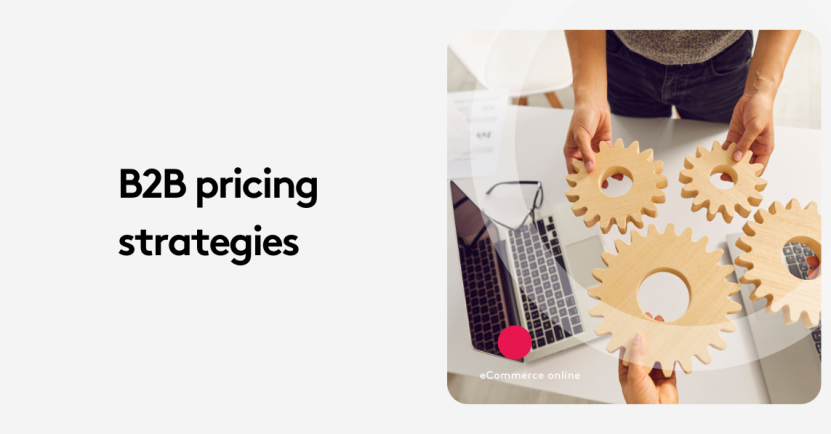
Pricing can make or break a B2B business, yet many companies rely on outdated or ineffective strategies. In this guide, we’ll break down the most successful pricing models—and expose the ones that could be costing you sales.
There are more decision-makers, the sales cycles are longer, and in many cases, the items tend to be high-ticket, meaning that you can’t merely copy the pricing strategies utilized in the B2C world.
In this post, you’ll learn why there’s a direct link between your business model and pricing, pricing strategies you can copy, determining what pricing strategy works best for your business, and more.
Key takeaways
- Business Model Impacts Pricing – Factors like branding, product differentiation, customer loyalty, and segmentation play a crucial role in setting B2B prices.
- 10 B2B Pricing Strategies – Methods like dynamic pricing, product bundling, regional pricing, and membership-based pricing can help optimize revenue.
- Common Pricing Mistakes – Issues such as inconsistent pricing across channels, excessive discounting, and lack of segmentation can hurt profitability.
- Choosing the Right Strategy – Businesses should evaluate cost-based, value-based, competition-based, and elasticity-based pricing to determine the best fit.
On this page:
How pricing is impacted by your business model
Establishing a price for your products can come down to factors such as branding, product differentiation, customer loyalty and customer segmentation.
How branding affects pricing
In many cases, a higher price is often linked to a higher product value. Your brand’s strength and the specific market you’re targeting can determine how effectively you can use your brand to influence pricing.
How product differentiation affects pricing
Differentiation is another way to determine pricing strategy if your products contain additional features or access to other services that your competitors can’t offer. Through product differentiation, you can provide different prices for similar versions of the same product.
For example, suppose your base product is priced at the average market price. In that case, you can also offer an entry-level product with fewer features for customers who’re interested in your products but find it outside of their budget.
Additionally, you can provide a premium-priced product and additional features and services for customers seeking that option.
How customer loyalty affects pricing
Depending on the loyalty level of your customers, you’ll be able to make subtle changes in your pricing without much negative impact.
An example of how a unique business model can impact price can be seen in how Apple prices its products for its B2C audience. Apple products are typically priced as the most expensive on the market, whether it’s the iPhone, a MacBook or additional accessory.
However, Apple’s branding and extensive product differentiation, coupled with raving customer loyalty, enable them to charge higher prices, consistently increasing the price of their products over time without losing their fans.
How customer segmentation affects pricing
By separating customers based on what they’re willing to pay for your products, you can optimize your prices accordingly.
Let’s again take Apple as an example, using the latest edition of the iPhone. Entry-level Apple customers may want an iPhone but not all of the features associated with it or find it outside of their budget. The iPhone SE provides an entry-level option for those customers. The average Apple customer may be content with the iPhone 12, and for others willing to spend a little more, there is the iPhone 12 Pro.
10 B2B eCommerce pricing strategies you can copy
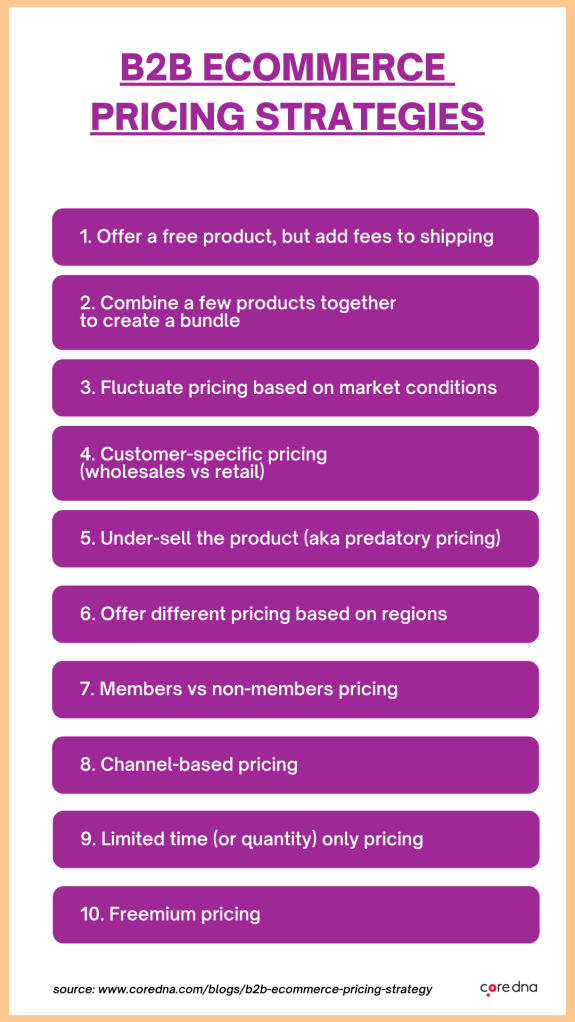
1. Offer a free product, but add fees to shipping
In a free plus shipping pricing strategy, products are sold for $0, and then charges are added to account for shipping costs.
This model is appealing to customers because they appear to be getting a product for free, but the eCommerce store can still ensure a profit by rolling the product's cost into the shipping cost.
The free product + shipping offer is especially great for introducing an entry-level product or being used as part of a more extensive marketing campaign to increase conversions.
For example, Grant Cardone's products cover B2C and B2B audiences. By selling this booklet for free+shipping, the company can build a more significant customer base and introduce them to other courses tailored to businesses and organizations.
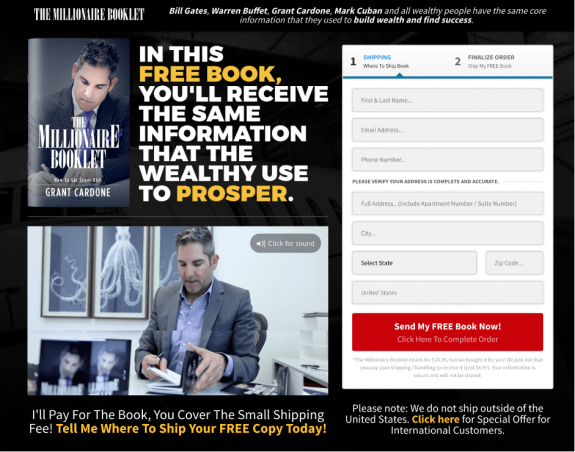
2. Product bundling
Bundle pricing means combining several products into one comprehensive package. In bundle pricing, the package price is usually lower than the total cost of each product sold separately.
Bundle pricing is a great way to direct customers to the specific packages that make the most sense and solve common related problems they might be having.
An example of bundle pricing in action can be seen in how AT&T bundles their internet package with voice or TV for businesses. This enables their customers to solve multiple problems at once and save money.
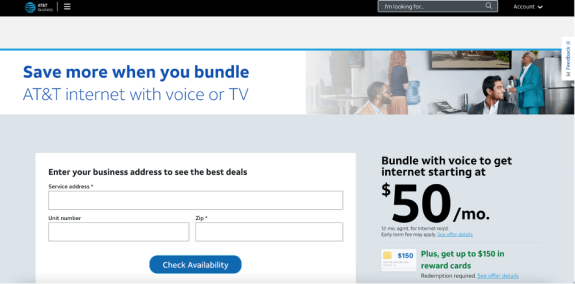
3. Dynamic pricing
Dynamic pricing is the process of fluctuating your products' prices based on factors such as industry standards, market conditions or customer expectations.
This pricing strategy can be implemented when you need to suddenly slash prices to cope with a new competitor or avoid making a loss due to too much inventory volume.
It's also very common to see dynamic pricing implemented when market conditions change. Dynamic pricing is used in several industries including retail, aviation, and transportation, specifically industrial and medical supplies in B2B markets.
For example, Uber frequently employs dynamic pricing or surge pricing when demand in specific areas is higher than usual, and there are fewer drivers to meet this demand.
For B2B companies, this same tactic can be applied in situations where demand for products is high but they can't meet the demand immediately due to a lack of resources.
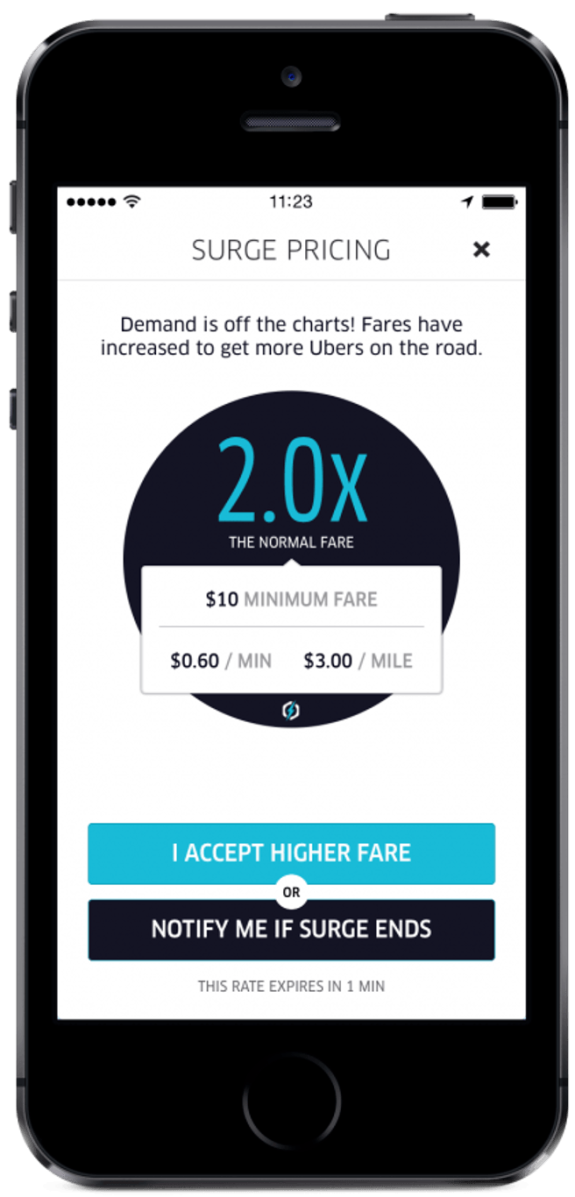
4. Customer-specific pricing (wholesales vs retail)
Customer-specific pricing is a way of personalizing the price for a customer. Unique pricing can be created for an individual customer or user group.
For example, if the customer decides to purchase items wholesale rather than retail, they can receive a discount; or SaaS companies that offer different tiers depending on the size of your website.
5. Under-sell the product (aka predatory pricing)
Predatory pricing is a way of undercutting competitors by offering customers products at a lower price than their actual value.
When this pricing strategy is implemented, it can create a race to the bottom, eliminating several competitors from the market because it creates an unfair market advantage. When done to the point of monopolization; however, predatory pricing can be deemed illegal.
For example, 3rd party sellers on Amazon and Amazon themselves frequently adjust their pricing to beat the competition in specific categories in an effort to win the Amazon Buy-Box.
The buy-box showcases other sellers on Amazon with the same item. With a lower price, you can entice customers to purchase from your store.
For B2B stores, an excellent time to use predatory pricing is when you're trying to sell out inventory quickly and you can afford to drop your price for some time without taking heavy losses.
6. Regional pricing
Regional pricing is the process of varying prices based on location. Customers in different areas or regions may end up paying a lower or higher price than those in another place.
For example, Evernote Premium is priced differently for US-based customers than for customers based in France. There is a slightly different price due to conversion rates with one price listed in dollars and the other in euros.
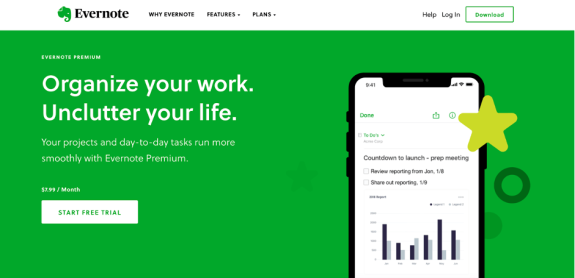
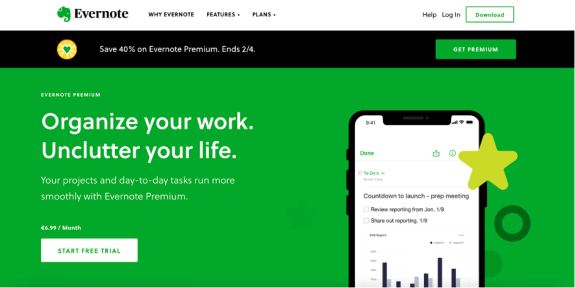
7. Members vs non-members pricing
If you have membership programs, you can provide different pricing structures, including additional discounts for members (depending on the tiers), whereas non-members will maintain the same price throughout.
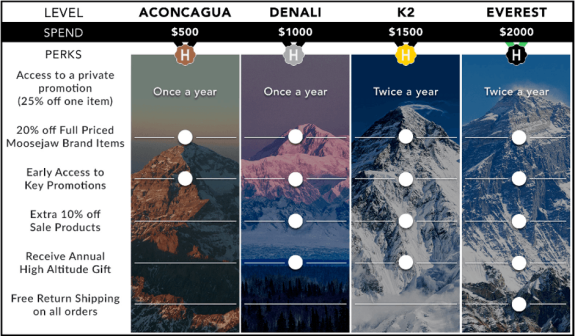
8. Channel-based pricing
Channel-based pricing enables eCommerce stores to offer different prices depending on the marketing channel that leads to the product.
For instance, different discounts can be presented to potential customers who access a store from an affiliate link or click on a Facebook ad.
For example, Asana's partnership program enables their partners and the customers they refer to receive discounts on membership if they sign up for Asana through the referral program.
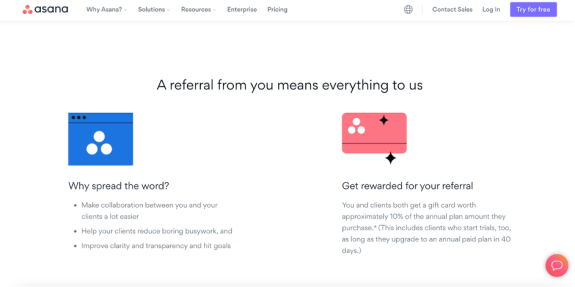
9. Limited time (or quantity) only pricing
In this pricing strategy, when there is a limited supply of a product and demand is high, the product's price continues to rise until supply and demand reach equilibrium.
An example of this tactic can be found when companies release new products or services and restrict access to invite-only.
Spotify uses this concept to roll out new availability and encourage premium signups. Spotify isn't available in every country, but initial registrations are limited to paid subscribers when it is available.

10. Freemium pricing
A popular pricing method among SaaS companies is the freemium pricing model. In this model, a simplified or basic product is offered for free.
However, a higher tier is available that provides additional features or capacity for a price. Pricing options are also available for small businesses and enterprise customers.
Zapier utilizes this model for their pricing options, offering different prices for individuals, small businesses, enterprise customers and more.

How to determine what pricing works for your products
A pricing strategy can help you to gain a distinct advantage over your competitors. Here are some of the options for determining which pricing strategy works for your business.
Value-based pricing
Value-based pricing focuses on the customer. Pricing is based on how much the customer values the product and its benefits.
An example of value-based pricing can be found in luxury brands such as Louis Vuitton. As a luxury clothing brand, Louis Vuitton creates a specific aesthetic and consistency that enables them to charge a higher price for their items since it is associated with a high-quality brand.
Pros
Value-based pricing can increase profits because a company can set the highest possible price for their brand, not base it on the cost of materials or the competition.
Cons
Drawbacks of this model are that it requires a firm understanding of the target market, including customers desires and personas. Value-based pricing can vary by niche, and even though the price isn't set based on the competition, the competition can impact the price.
When to use value-based pricing
Use value-based pricing if the product you are selling carries an emotional appeal to a specific audience, or there is an element of scarcity attached to it.
Cost-based pricing
In this model, the price is decided by the cost to make, distribute and market the product. Once that total cost is known, the desired profit or profit percentage markup is then added to the selling price.
Cost-based pricing can be seen in eCommerce stores that purchase products wholesale and then sell items to their customers at a retail price.
For example, large retailers such as Walmart can buy products in bulk from a manufacturer and then distribute them to their customers in-store at retail prices to secure profits.
Pros
This pricing method is advantageous because it can be easy to determine a price and can be useful for newer products where there is no established basis for using another pricing strategy.
Cons
However, this method can result in underpricing or overpricing products because customer demand and the competitive landscape aren't considered.
When to use cost-based pricing
Use cost-based pricing when releasing a new product with limited market data. Add a percentage markup to the product after factoring in the price to source materials, distribute and implement marketing. Afterwards, you can build another pricing strategy with the new data you've discovered.
Competition-based pricing
In this strategy, price is set based on the competition landscape. In highly competitive markets where the products are similar, a business may price its products at a comparable price to the competition and then seek to compete in other areas such as branding and marketing. This also enables companies to compete by lowering costs.
An example of this pricing can be found in how brands such as Coke and Pepsi offer similar products at similar prices, but use branding, promotions, influencers and more to help them differentiate themselves.
Pros
Competition-based pricing can be simple to implement and offers a lower risk factor than other pricing strategies.
Cons
However, it can lead to missed opportunities because there's too much emphasis on the competition and not your own brand, and can promote a set it and forget it mentality.
When to use competition-based pricing
Use this pricing strategy if you are selling a product or service in a crowded market. You can then focus your efforts on differentiating your brand in other areas such as content and marketing or customer service.
Elasticity-based pricing
Pricing elasticity refers to how sensitive the demand for a product is to changes in price. The specific product determines elastic-based pricing.
An inelastic price indicates that as the price increases, the demand remains unchanged. An item with higher elasticity, however, will see demand drop if the price is increased.
An example of elastic-based pricing can be found in smartphones. When the first iPhone was launched, the price was around $499. Prices have now ballooned to over $1000 in some cases, yet the global smartphone market's growth has continued since 2007 and remained steady over the last 3-4 years.
Pros
The pricing strategy won't need to be changed too often.
Cons
New products and innovations can eliminate the market completely. For example, how streaming removed the need for people to purchase movies on video.
When to use elasticity-based pricing
Use this pricing strategy if you are selling a product that is considered a commodity. You can then adjust the price with the market based on any increases or decreases in overall demand.
15 eCommerce pricing mistakes you’re probably making
To get your B2B eCommerce strategy done right then, it's essential to avoid these common mistakes:
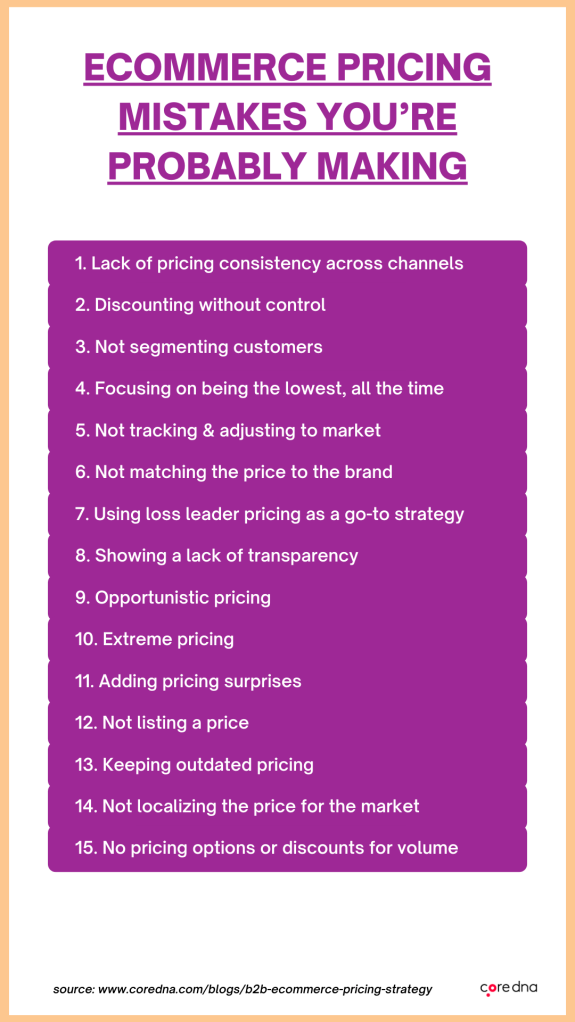
1. Lack of pricing consistency across channels
Inconsistent pricing, such as having products listed as high-end products on your website and then a group of products consistently offered at an 80% cheaper rate via select marketing channels can lead to problems with how customers perceive your brand. It can also lead to them taking advantage of that channel, ruining your bottom line.
To prevent this maintain a consistent pricing strategy across all channels so that you don't have too many tiers and can easily ensure consistency.
2. Discounting without control
Discounting can be a great way to sell more products in a brief period and boost brand awareness. However, if products are discounted without any rhyme or reason, then your brand could be questioned, and your customers could be conditioned to expect discounts.
Instead, create a system for discounting at special predetermined times and focus on improving the customer experience.
3. Not segmenting customers
When you don't segment your customers, you run the risk of offering the same products, discounts and more to all of them. This means you don't create a personalized experience that is unique to each customer persona, which can negatively impact your conversions.
Instead, create different customer segments and personas so that you can tailor the experience for each customer group, such as your repeat customers vs new customers.
4. Focusing on being the lowest, all the time
You don't want to end up in a race to the bottom because eventually, you won't be able to get back up. Instead, experiment with prices and pricing strategies using A/B testing or any other method you can think of until you find the sweet spot for your brand.
5. Not tracking competitors' pricing and adjusting to market
If you don't track your competitors' pricing, that means you don't fully understand your market and won't respond to changes or predict what might happen.
Don't just set pricing and ignore other factors that affect the market. Continue to research what's happening in the marketplace so that you can position your brand for success.
6. Not matching the price to the brand
You can't charge a premium price for your product without providing premium customer service or marketing as well.
Similarly, if your brand is presented as a premium brand, then the price should reflect that.
To prevent this, make sure all aspects of your business are alignment with the price you demand from your customers.
7. Using loss leader pricing as a go-to strategy
In this situation, brands may expect loyalty because they provide something at a cheaper cost. If you don't build a rapport with your customers and continually provide them with more than just the product they asked for, they won't have a reason to go back to your brand.
Instead, seek ways to build relationships with your customers by providing them with regular updates about your products, following up after purchases and asking for feedback.
8. Showing a lack of transparency
Customers trust expensive brands and their products because they're able to showcase their value and longevity. Failure to demonstrate your product's value can leave customers asking why it costs so much or wondering about the value they're getting.
Be transparent with your pricing and highlight the reasons why customers should be willing to pay the price you're asking for your product.
To prevent this issue, take opportunities to showcase to your customers why products are priced a certain way and demonstrate value by using testimonials or as part of email campaigns.
9. Opportunistic pricing
Opportunistic pricing can leave a bad taste in your customer's mouths and ruin your relationship with them.
For example, some companies raised their products' price to capitalize on demand at the start of the pandemic. Doubling or tripling the price for items without any valid reason can result in your customers losing trust in your company.
Instead, if prices need to be raised for a specific reason such as an overly expected increase in demand, take the opportunity to alert your customers as to the reasons why.
10. Extreme pricing
Avoid extreme pricing thresholds such as overvaluing your product and pricing it too high or undervaluing it and pricing it too low. Instead, research the market to see what's currently available and avoid ripping customers off or making them question the quality of your product.
11. Adding pricing surprises
An unexpected discount may be welcome, but excess handling fees or surcharges can impact your conversion rates.
To prevent this, try to factor in any potential excess costs into the initial sticker price so that customers are well aware of what they're getting into.
12. Not listing a price
Another tactic to avoid is hiding the price of your product. Many B2B eCommerce brands especially may consider this so that competitors don't know how much their products are priced at.
However, this can turn off customers as they need to do extra work to see if your price is even within your budget.
Instead, offer a "starting at" price point so that customers can at least determine if your product or service is likely to be within their budget.
13. Keeping outdated pricing
If you ran a campaign but forgot to put an end-date, you could find yourself with outdated price listings which can be confusing customers. To prevent this, plan any discounted campaigns for a specific period so that customers are aware of when the campaign is ending.
14. Not localizing the price for the market
While eCommerce in many cases exposes you to global markets for your products or services, that doesn't mean you can list the same price for every market.
You will need to introduce regional or international pricing to appeal to specific market segments and get pricing correct in many cases.
15. Not having pricing options or discounts for volume
Buying in bulk is beneficial for your business, but you should also make it worthwhile for customers. Provide options that enable your customers to receive discounts if they purchase higher volumes of products.
Choose an eCommerce platform that makes setting up different pricing strategies easy
Given the pitfalls that occur when you get pricing strategy wrong, and the importance of pricing to eCommerce success, it’s crucial to select the right platform for your B2B business.
Core dna’s headless eCommerce platform enables you to manage all facets of your B2B eCommerce store and deliver your customers’ best digital experience. Not only can you manage your entire inventory, but you can manage your pricing as needed.
Bundled pricing, personalized pricing, dynamic pricing and more are all available for you to implement the pricing strategy that best suits your brand.
Still working on your B2B eCommerce strategy? Discover everything you need to know for your B2B eCommerce store by reading B2B eCommerce: Best Practices, Marketing Strategy & Myths.













